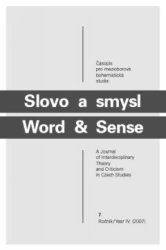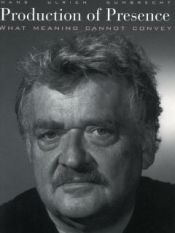0Putting aside the many precautions taken by Hans-Ulrich Gumbrecht to expound his position with nuance, one can bluntly summarize his main thesis in The Production of Presence as follows: it is time to question the omnipotence and centrality gained by “interpretation” as a research practice in the humanities; more precisely, the epistemological framework implied by “interpretation” must be shifted, so as to create a locus for theory which is, in the author’s own terms, nonhermeneutical and nonmetaphysical. In essence, the humanities are enjoined to renounce their purely meaning-based epistemology, and “get their hands dirty” (78) by engaging with the bodily, sensorial dimension of the world, its very “presence”, “substance” – and even “Being”.
0This, by all accounts, – indeed, by Gumbrecht’s own account in The Production of Presence – is a rather controversial view of the task of the humanities, a one, in truth, often considered to be a paramount of intellectual bad taste and philosophical naďveté.
0Bearing this in mind, there is one quality that must impress in Gumbrecht’s opus, notwithstanding the opinions one may entertain generally about his work and ideas: it manages to be unpolemical in spirit – indeed, its overtones are oftentimes quite irenical – in a most polemical of debates. Nowadays (at least in the Anglo-Saxon world), it is a tall order to question the dominance and centrality of “interpretation” without tumbling into the pit-fall of an outright criticism or a somewhat naďve rejection, but Gumbrecht seems to manage just that. Most of the polemical sting is taken out of his questioning of interpretation and its claim to universality by his admission that he is not rejecting it as such, but rather seeking a richer and broader understanding of its implications, which ideally would manage to overcome its exclusive concern with meaning. The quest for presence he is advocating does not imply an obturation of the dimension of meaning fundamental to interpretation: rather, he imagines a necessary “oscillation (and sometimes […] interference) between ‘presence effects’ and ‘meaning effects’”(2). In an other prudent move, Gumbrecht claims that he is only leading the humanities towards a nonhermeneutical future, but that, for a cruel lack of adequate concepts, he cannot yet know exactly how it will look like. As he therefore states at the beginning of his book, his claim to go beyond interpretation is in essence “anticlimatic”: it foregoes asserting a brash new theoretical position and simply “pledges for a rethinking and, ultimately, for a reconfiguration of some of the conditions of knowledge production within the humanities” (2).
0The methodological restraint Gumbrecht allies to his very bold and wide-ranging claim on the necessary future epistemological orientation of the humanities is all the more significant when one acknowledges that The Production of Presence represents“ a comprehensive version of [his] thinking” (publisher comments). The thesis defended in this book is the result of a long personal theoretical quest, which he is anxious to recount from its very inception in the 80s during the colloquiums on the “Materialities of Communication”, when he first turned his attention to presence and, as he put it, the “phenomena and conditions that contribute to the production of meaning, without being meaning themselves”(8). His pledge for an epistemological shift is therefore explicitly grounded in a life-long reflection; it is consciously presented as a mature and well-pondered position.
0In an effort to further contextualize the question of interpretation and underscore the deep-rootedness of the problem raised by its extreme meaning bias, Gumbrecht situates his argument more generally by briefly retelling the history of Western metaphysics. He thereby tries to highlight the following facts: firstly, the hegemony of interpretation as a meaning-only epistemological paradigm is not a universal constant; its historical origins can be traced back to Early Modernity and the subordination – enshrined by the Cartesian metaphysics of the cogito – of all the things of the world, including the human body, to the mind. Ours, according to Gumbrecht, is a typical “meaning culture”, which can be opposed to “presence cultures” such as the pre-Socratic or medieval cultures, in which preeminence is given to the body. Secondly, the “Cartesian” exclusion of presence from metaphysics (or from the “hermeneutic field”) is highly problematical, and manifests itself as such at the latest with Kant’s Critiques. Gumbrecht thus remarks that “the emergence of aesthetics, as a subfield of philosophy, in the eighteenth century, makes it clear that, counter to the premises of the hermeneutic field, world-appropriation through the human body […] was now also reappearing as an epistemological option” (37). As a consequence, a continuing tension between meaning and presence can be traced throughout the XIXth and XXth century, in the various attempts by thinkers and writers such as Flaubert, Nietzsche, Freud, Bergson and Heidegger to find a connection between intelligible concepts and the human senses.
0Among these thinkers, Heidegger is singled out as of particular importance, as he provides the conceptual framework needed to mark out a first, admittedly provisory, model of the nonhermeneutical epistemology being called for (Bohrer, Nancy, Steiner, Butler are also mentioned as relevant contemporary thinkers to that end). Foremost is the Heideggerian idea of “unconcealment of Being”, which interests Gumbrecht because of the link it establishes between the purpose of metaphysics and the things of the world. ‘Being’, for Heidegger, is neither conceptual nor spiritual, but belongs to the dimension of things; it therefore resists any seamless integration in a traditional ‘Cartesian’ metaphysics – preoccupied only with meaning – and can thus “help us grasp noninterpretative components of our relationship to the world” (86). In consequence, we are treated to a longish discussion of Heideggerian “Being”, punctuated by a typology of Gumbrecht’s own concepts (eating, penetrating, mysticism and interpretation/communication), the whole point of which is, in end effect, to highlight the importance of various modes of world-appropriation that go beyond meaning (rather than provide a refined conceptualization of the nonhermeneutical regions they point towards).
0On the basis of this discussion and his still rather unrefined concepts, Gumbrecht goes on to elaborate on presence and seeks for a more detailed description of the future nonhermeneutical landscape of the humanities. What he comes up with is a three-pronged proposition, addressing respectively the significance of presence for aesthetics, history and pedagogy. First and foremost, he introduces presence as epiphany, or in other terms, an aesthetic “moment of intensity” which has nothing edifying, “no message, nothing that we could really learn from” (98). Its distinctive features are quantity (not quality), remoteness from everyday life or “insularity”, suddenness, focus. Epiphany implies a “staging”, through which a “complex and embodied form” (113) is presented. It also implies an element of violence, and importantly, requires a certain loss of control, or serenity and composure (Gelassenheit) to be experienced. Secondly, presence is obtained through the presentification of the past. Assigning meaning to history is not the only way of understanding and appropriating the past: one can also try to immerse oneself in it and enliven it. Finally, presence is achieved in academic teaching through deixis, that is, through a “staging of complexity” that must be practiced in the modality of “lived experience”: good teaching must show or bring forth its object, rather than simply interpret and impose meaning onto it.
0Epiphany is obviously the essential component of Gumbrecht’s epistemological conception of presence: presentification and deixis are much more “methodological” and address possible applications of presence within the practice of the humanities. In our eyes though, the definition of presence through epiphany is a weaker moment of the book. One had been warned to expect an anti-climax, but a measure of disappointment with “epiphany” is still justified: indeed, defining presence by it seems to establish exactly the converse to the book’s objectives, that is, far from coming nearer to understanding the “tension” and “oscillation” of presence and meaning effects, a radical separation is entrenched between them: presence is but a brief and ephemeral “moment of intensity”, isolated from and unrelated to the meaningfulness of everyday life. True, Gumbrecht mentions Niklas Luhmann’s thesis that a possibility to experience meaning effects and presence effects in simultaneity may be found in art. True also, Gumbrecht points out that such aesthetic epiphanies as can be found in art (but not only), despite their insularity from everyday life, should be understood as giving rise to a general experience (erleben) – and can be thus said to be meaningful since they reveal the very nature of the things of the world. But he then states that this “epiphanic” experience, insofar that it reactivates our bodily dimension, meets the things of the world “in their pre-conceptual thingness” (118), or in other terms, in a form totally bereft of meaning. The case for presence is thereby overstated, since no room is left for any role that meaning might play in our bodily appropriation of the world. Significantly, Gumbrecht embraces a Wittgensteinian vow of silence in his final chapter, enjoining us to “be quiet a while” and renounce to produce meaning if we are to overcome the modern sense of loss of the world induced by too much interpretation: he does not envisage nor suggest a positive method (silence can hardly be characterized as such) for the humanities, through which they could attempt, as Gumbrecht thinks they should, to investigate, conceptualize and take control of the fundamental tension between meaning and presence.
0This weak point of the book is an obvious place to attack it, and Gumbrecht’s critics have not failed to do so, accusing him of having become a “religious thinker”. This attack Gumbrecht finds he cannot really counter, and interestingly, meets with relative indifference. In a sense, Gumbrecht’s equanimity with the charge of having become a religious thinker is quite understandable and can be traced back to the fact that he is discussing an “irrational” way of relating to the world, and that he makes free use quasi-religious terminology and concepts (epiphany, loss of control, etc.). By de facto giving precedence to presence over meaning in his concept of epiphany, he also certainly seems to give priority to ecstatic, “naďve” modes of worldappropriation, more associated with religion or religious experience than with the intellectual reflexivity and concentration (i. e. the opposite of Gelassenheit) characteristic of the humanities.
0This apparent “religiosity” of the epistemological shift asked for by Gumbrecht should not, however, be accepted as a convincing put-down of his plead for more attention to the dimension of presence. It is unmistakable that he has hit on a real problem at the heart of the humanities, and that in essence, his reaction is appropriate. In a way, it is probably precisely because he is trying to appropriate for the humanities a knowledge traditionally reserved to theology that his is confronted with the accusation of becoming a religious thinker. Maybe one could say though that in his battle “to conquer the potential concepts of a nonmetaphysical future” (91), Gumbrecht doesn’t choose his main intellectual ally very wisely. True, his assertion that “even now, no attempt at overcoming metaphysics and its consequences can disregard Heidegger’s work” (47) is not altogether wrongheaded; there are two reasons, however, to regret this institution of Heidegger’s work at the center of the contemporary quest for presence. For one, it is barely probable that a direct recourse to the concept of Being might be readily accepted within the context of the humanities as a credible founding bloc for a new nonhermeneutical framework: accusation of religious or “loose” thinking are certainly related to this choice and to the general direction it imparts to Gumbrecht’s conception of presence as an epiphanic, ecstatic experience.
0Even more significantly, Heidegger is not the only thinker to wish to overcome “metaphysics”. Nietzsche’s or Bergson’s efforts to go beyond metaphysics antedate his own. More significantly, we can find a whole range of thinkers, among whom Merleau-Pontyand Patočka figure prominently, who develop Heidegger’s thinking and make the case for presence – through the prism of “perception” – in a much more “precise” way, more amenable and relevant to contemporary minds. Also, the slavist in us can’t help but wonder if more attention to the studies of poetics by the Russian Formalists or Czech Structuralists could not have provided Gumbrecht with an intriguing template to further examine his idea of a tension between meaning and presence: for surely, the relation between sound and meaning they investigate so exhaustively presents a paradigmatical case of that “oscillation” he talks of.
0All in all, there thus seems to be many avenues along which to steer Gumbrecht’s stimulating thought – away from Heidegger and “religious” thinking – towards a nonhermeneutical field really relevant for the humanities. It is the merit of The Production of Presence to strongly make the case that striving towards that goal should be fruitful, or even necessary.





